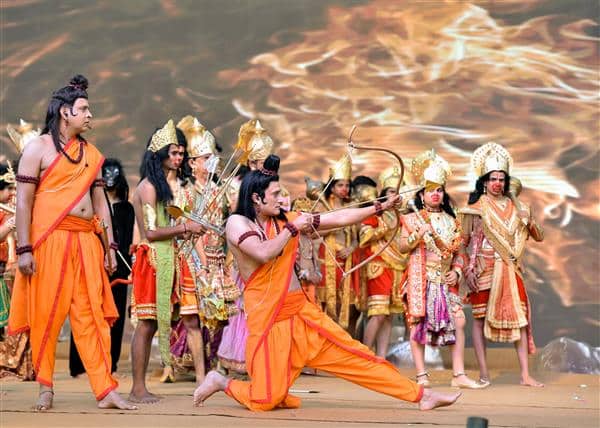What’s in Today’s Article?
- Why in News?
- What is Ramleela?
- How did Indians Reach Trinidad?
- How did Ramleela Reach Trinidad?
- Present Status of Ramleela in Trinidad
Why in News?
- Ramleela is one of India’s most famous folk theatre traditions, performed across the country during the autumnal (October) Navratri celebrations.
- Ramleela has travelled to distant corners of the world with the Indian diaspora and one such example is Trinidad, an island in the Caribbean with a significant Indian population.
What is Ramleela?
- Basically, Ramleela is a dramatic re-enactment of Tulsidas’s Ramcharitmanas, telling the story of Lord Ram.
- Major incidents in the epic are covered in an episodic way, with an interplay between dialogue and musical verses.
- Performances last days, and culminate on Dussehra with the burning of the effigy of Ravan, representing the victory of good over evil.
- In this broad form, Ramleela has travelled to distant corners of the world with the Indian diaspora.
How did Indians Reach Trinidad?
- In early 19th century Britain, with the calls to abolish slavery intensified, slave trade was banned in 1807, and finally abolished in 1834 in the British Empire.
- This, however, created a massive problem in many British colonies whose economy depended on slave labour.
- The island of Trinidad, where sugar formed the backbone of the economy, was one such colony.
- In 1838, the enactment of the emancipation legislation in Trinidad was followed by a large-scale emigration of emancipated slaves from the sugar estates.
- Plantation owners, desperate to keep their economy afloat, turned to indentured labour from India.
- On May 30, 1845 the very first boatload of indentured Indians came to Trinidad.
- While seen as more human than slavery, indentured servitude was nonetheless brutal for labourers.
- Today, Indians – mostly descendants of these labourers who continued to enter Trinidad as late as 1917 – form the largest ethnic group in Trinidad (~35% of the total population).
- Most came from the present day eastern UP and Bihar.
How did Ramleela Reach Trinidad?
- When travelling to these distant lands, indentured individuals were unable to carry many material possessions. However, they did bring their culture.
- This is how Ramleela arrived in Trinidad. In villages in the countryside, now thronged by Indians speaking Bhojpuri and eating chapatis, Ramleela saw widespread participation of the community.
- Although Ramleela has evolved over the years to become more Trinidadian, it remains the foremost representation of Indianness of Indian diaspora, thus, becoming an anchor to their roots back in India.
Present Status of Ramleela in Trinidad
- By the latter half of the 19th century, the popularity of Ramleela in Trinidad started dwindling.
- As formal education spread, Bhojpuri was slowly replaced by English among the Indian population.
- As a result, younger generations were not as familiar with the Manas as their predecessors.
- This decline was made worse by a steady migration of Indians into urban spaces, leaving behind their former social life that revolved almost completely around Hindu festivals.
- Now, youth encountered other cultural influences like the Carnival, an annual cultural high point for Trinidadians.
- But these factors also made Ramleela ripe for innovation. Today, gender and caste restrictions on participation have been loosened, new dramatic techniques embraced, and dialogue simplified to appeal to younger audiences.
- Most importantly, as Indian-origin Trinidadians have become more powerful in the country’s politics, Ramleela has parallelly enjoyed renewed attention, financial and otherwise.
Q1) What is at the foundation of the India-Caribbean relations?
The vibrant community, their ethnic connections with India and common colonial history has laid the foundations for the India-Caribbean relations that have come to circumnavigate distance and other challenges.
Q2) Which Caribbean has the most Indians?
Indians number around a million of the Caribbean’s population. They are the largest ethnic group in Guyana, and are becoming the largest group in Trinidad.
Source: How Ramleela Reached Trinidad and Became a Representation of ‘Indianness
Last updated on December, 2025
→ Check out the latest UPSC Syllabus 2026 here.
→ Join Vajiram & Ravi’s Interview Guidance Programme for expert help to crack your final UPSC stage.
→ UPSC Mains Result 2025 is now out.
→ UPSC Notification 2026 is scheduled to be released on January 14, 2026.
→ UPSC Calendar 2026 is released on 15th May, 2025.
→ The UPSC Vacancy 2025 were released 1129, out of which 979 were for UPSC CSE and remaining 150 are for UPSC IFoS.
→ UPSC Prelims 2026 will be conducted on 24th May, 2026 & UPSC Mains 2026 will be conducted on 21st August 2026.
→ The UPSC Selection Process is of 3 stages-Prelims, Mains and Interview.
→ UPSC Result 2024 is released with latest UPSC Marksheet 2024. Check Now!
→ UPSC Prelims Result 2025 is out now for the CSE held on 25 May 2025.
→ UPSC Toppers List 2024 is released now. Shakti Dubey is UPSC AIR 1 2024 Topper.
→ UPSC Prelims Question Paper 2025 and Unofficial Prelims Answer Key 2025 are available now.
→ UPSC Mains Question Paper 2025 is out for Essay, GS 1, 2, 3 & GS 4.
→ UPSC Mains Indian Language Question Paper 2025 is now out.
→ UPSC Mains Optional Question Paper 2025 is now out.
→ Also check Best IAS Coaching in Delhi

















